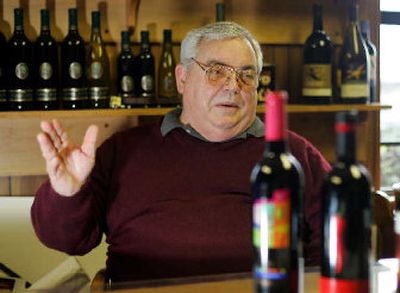Low price uncorked

NAPA, Calif. – First came Two Buck Chuck. Now, there’s Four Buck Fred.
Fred Franzia, the maker of the famously cheap wine sold at Trader Joe’s supermarkets nationwide, is releasing two new wines under his Napa Creek label, both going for $3.99 a bottle.
The twist: This time the wines are actually made with grapes from California’s Napa Valley.
“This shows that you can put Napa Valley wine in there for the price that we’re doing,” says Franzia. “People want to buy things at a reasonable price that are good value. It’s not new. It’s America.”
In Napa, where wine is more likely to cost $40 than $4 a bottle, the release was a shocker.
An enormously successful California vintner, Franzia has been fighting with Napa winemakers – so far unsuccessfully – over a state law requiring that wines with “Napa” on the label be made from grapes grown in that region.
The Napa Valley, about 65 miles northeast of San Francisco, is relatively small, producing only about 4 percent of California’s wine by volume, according to the Napa Valley Vintners association. But the region packs a big financial punch, accounting for 21 percent of the wine industry’s $45 billion economic impact on the state’s economy – including revenues from winemaking, tourism and other allied businesses – according to the association’s numbers.
Along with prestige comes high prices. Napa Valley vineyard land can easily reach six figures an acre, and the average price for cabernet sauvignon grapes here is $4,000 a ton, compared to a statewide red grape average of about $600.
Napa vintners argue that putting the “Napa” name on a bottle of wine made with cheaper grapes grown elsewhere in the state undermines their image and undercuts their hard work in building up the valley’s reputation.
Franzia’s Bronco Wine Co. has argued that state law doesn’t trump similar federal regulations, which exempt brands established before 1986. Over the years, Bronco has purchased three such brands – Napa Ridge, Napa Creek Winery and Rutherford Vintners.
The California Supreme Court has upheld the labeling law, and the U.S. Supreme Court declined to hear an appeal. Meanwhile, a state appellate court in May ruled against arguments that the law impinges on Bronco’s free speech rights, hampers interstate commerce and unconstitutionally deprives Bronco of income without compensation. Bronco may ask a higher court to review that ruling.
Napa Creek was announced days after the appellate court ruling, but Franzia says that was a coincidence. Bronco spokesman Harvey Posert notes it takes months to get a new wine in stores.
The new Napa Creek wines – a chardonnay and a merlot – stem from Bronco’s practice of buying some Napa Valley wine to blend into various brands.
This year, Franzia found himself with enough for a separate release.
The wines carry the Napa Valley appellation, which means they must be made 85 percent from grapes grown in that region. They sell only at Trader Joe’s, as does Two Buck Chuck, officially called Charles Shaw, which sells for $1.99 in California and up to $3.39 elsewhere in the country.
Some vintners wondered how Franzia could possibly be making a profit on the new wines.
He’ll say only, “I don’t do anything unless I make money.” Others couldn’t help but smile.
“I’m glad to see Freddy using Napa Valley grapes in Napa Valley wine,” chuckled Mike Moone, founder of the boutique winery Luna Vineyards.
Moone thinks Franzia is doing Napa Valley a service by buying up surplus inventory. He notes that Bronco – which controls everything from vineyards to delivery trucks – is in a unique position to cut costs.
Franzia owns Bronco along with his brother and cousin and divulges few details about the privately held company.
The Ceres, Calif.-based company owns more than 35,000 acres of vineyards and is estimated to have more than $300 million in annual revenues. Bronco’s bottling plant on the outskirts of Napa can produce more than 200 million bottles a year.
Most wineries aren’t capable of realizing Bronco’s economies of scale, says Karen MacNeil, author of “The Wine Bible” and chairwoman of the wine department of the Culinary Institute of America’s California branch.